Korfball drills
- The ball is in front of the post by white.
- The red player runs out, gets the ball and shoots directly.
- Red catches off, plays to white and runs out, gets the ball and shoots.
- Blue catches off, plays to white, runs out, gets the ball back and shoots.
- etc.
- After 5 shots, everyone changes positions. Everyone 3 times declarer.
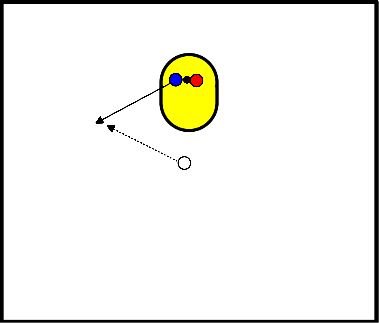
Work with 3 or 4-person teams:
- Make 15 through balls without missing
- 20 distance shots on the move, maximum 2 shots in a row.
- 15 dodge balls with double effort, so pass back and dodge again, the server gives light pressure on the shot.
- 20 step-off balls behind the basket, indicating from a breakthrough, then the rebounder steps off and shoots. Step on time, not too early.
- 15 penalty throws without missing. Take them alternately.
- 20 shots from standstill at 3/4 yards; grab the focus.
- Player blue must get the ball to one of the 4 pawns.
- Player red must pre-defend.
- Player red must close ball line.
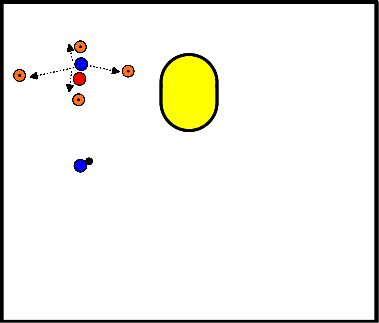
- Divide into two teams.
- Make two boxes around the basket so that good shots can be made from outside.
- Need 3 or 4 balls per game.
- Shooters stand outside the box and one rebounder per team stands in the box near the opponent's shooters.
Exercise:
- The shooters start shooting from outside the box to get to X number of goals as fast as possible.
- The rebounders catch the ball and play it to their fellow players in the other box.
- Which team will have scored X number of goals first.
Rules:
- Rebounders are not allowed outside the box, shooters not in it.
- The rebounder's job is to estimate as quickly as possible where all the balls are coming and how to get them to your teammates as quickly as possible.
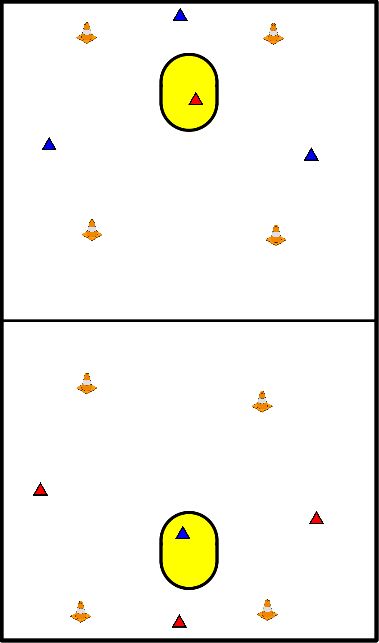
Work with 2- or 3-person teams:
- The second player starts when the first is at the second speed ladder.
- With 3-pairs, there is always a rest until the third is at the 2nd speed ladder.
- 2 speed ladders are 10 meters apart.
Exercise:
- You go left sideways through the speed ladder, knees up.
- Then you sprint to the other speed ladder.
- There you go right sideways through it, knees up.
- Slowly backward back to the starting point.
- Everyone does this 5x.
The other players take swerve balls until it's their turn.
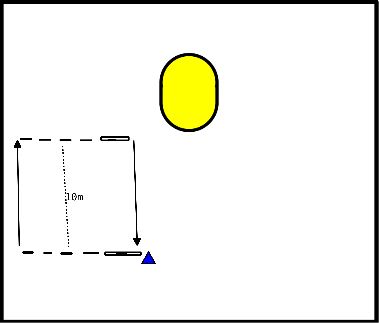
- Half of the group is attacker, blue, and the other half is defender, red.
- The attackers stand on the sideline and the defenders stand about 1 meter in front of them.
- The attackers run forward and try to get past the defender at half speed.
- The defender follows the attacker's every move while running backwards with them.
- Once across, the attackers and defenders switch roles.
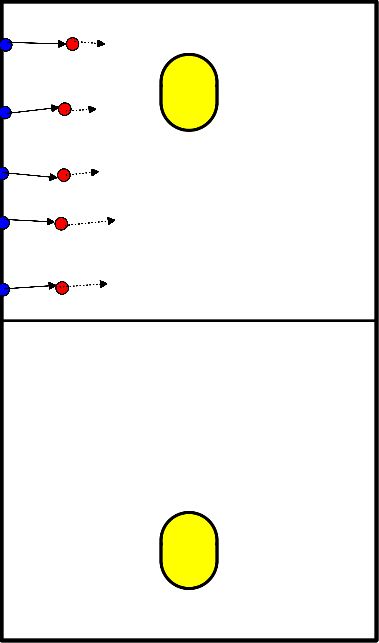
Building up to offensive positions to fall back on when creativity fails for a while.
Blue = static starting positions
Setup:
- Pass deep from front field
- Pass laterally into backfield + rebound run in
- Pass deep from backfield + run in support
- Pass passed to incoming support + attacking action by both strikers
- Support plays free striker + runs out into space
- Offloaded striker shoots
Once static has been mastered, move to dynamic. Agreement is that support follows immediately after rebound. The rest can be filled in freely with the variations below:
- Support runs around the block instead of cutting into it.
- Support does not shoot, but plays shadow striker to shoot. 7a.
- Offloaded striker does not shoot, but plays run-out striker to shoot. 7b.
- Played run-out support does not shoot, but shadow striker runs into support and takes over function + attack action strikers and shoot. 8.
- Played run-out support does not shoot, striker runs into support and takes over function + shadow striker connects with run-out support + strikers attack action and shoot. 9.
- ... innumerable variations to think of
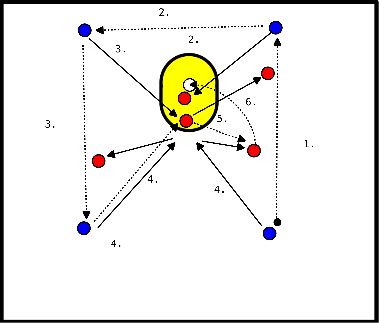
Building up to offensive positions to fall back on when creativity fails for a while.
Blue = static starting positions
Setup:
- Pass deep from front field
- Pass laterally into backfield + rebound run in
- Pass deep from backfield + run in support
- Pass passed to incoming support + attacking action by both strikers
- Support plays free striker + runs out into space
- Offloaded striker shoots
Once static has been mastered, move to dynamic. Agreement is that support follows immediately after rebound. The rest can be filled in freely with the variations below:
- Support runs around the block instead of cutting into it.
- Support does not shoot, but plays shadow striker to shoot. 7a.
- Offloaded striker does not shoot, but plays run-out striker to shoot. 7b.
- Played run-out support does not shoot, but shadow striker runs into support and takes over function + attack action strikers and shoot. 8.
- Played run-out support does not shoot, striker runs into support and takes over function + shadow striker connects with run-out support + strikers attack action and shoot. 9.
- ... innumerable variations to think of
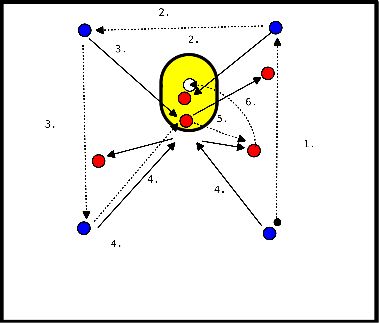
- Player 3 picks up the ball and throws it to player 1.
- Player 3 runs to the post.
- Player 4 goes over block, player 3 to the pointer.
- Player 1 throws the ball to player 2.
- Player 2 throws the ball to player 3 who enters the give way.
- Player 3 dodges and gets the ball moving, behind the post, and shoots.
- Player 4 connects, next to player 3.
- Player 1 runs to the front of the post and keeps the player engaged until shot.
- Player 2 takes player 1's position and after the shot goes to the post for the double-catch, ball over the basket.
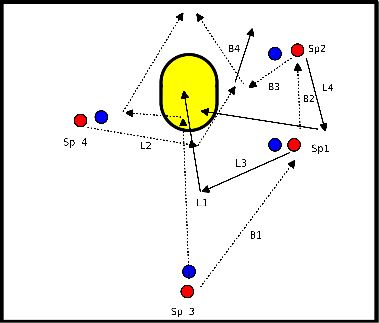
- Build up to offensive positions to fall back on when creativity fails.
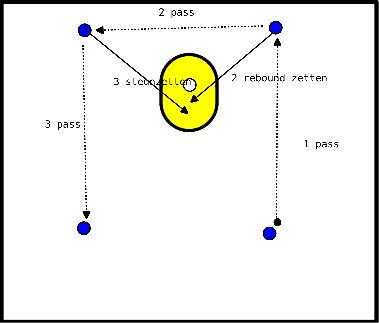
- Make 2-person teams
- 1 player is shooter and the other player stands under the basket to trap.
- They shoot 2 times and then switch.
- When the shooter scores, they may take a cap from the middle.
- When the caps in the middle run out, the player may take them from the other 2-times.
- Whoever has the most caps at the end has won.
- You form 2 teams with the same number of players.
- Each team has its own box.
- On the back line of that box, both teams have tall pawns upside down.
- The trick is for the other team to knock over the pawns.
- Using fending off and defending the pawns you can win with your team.
- All pawns of the opponent to then won.








